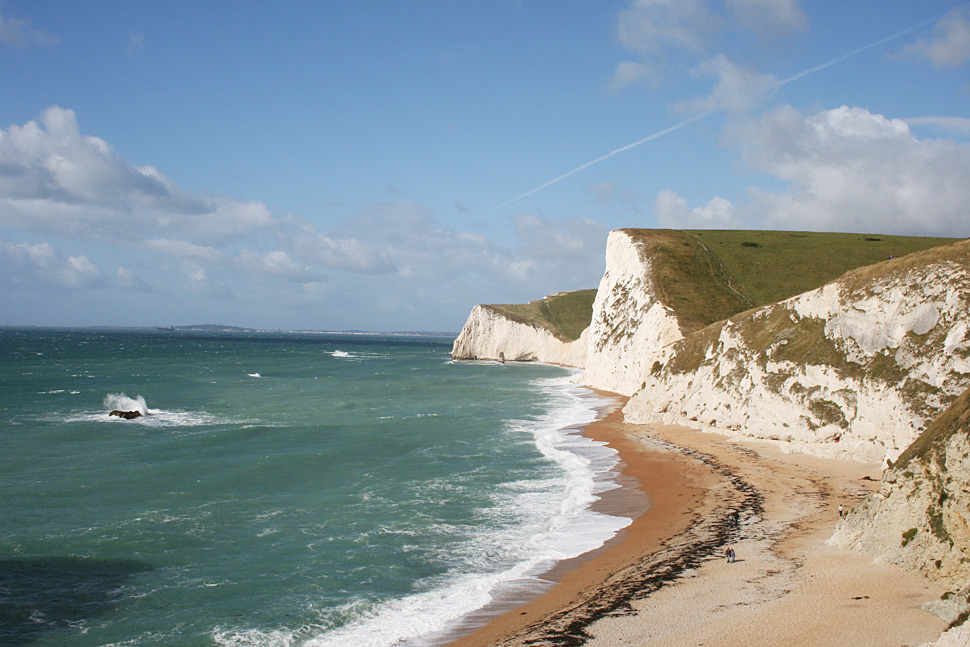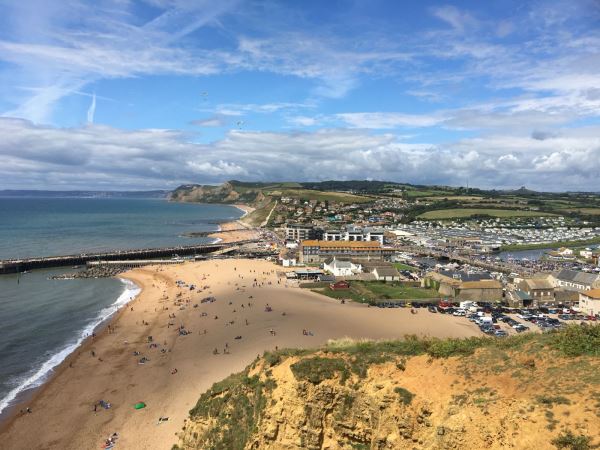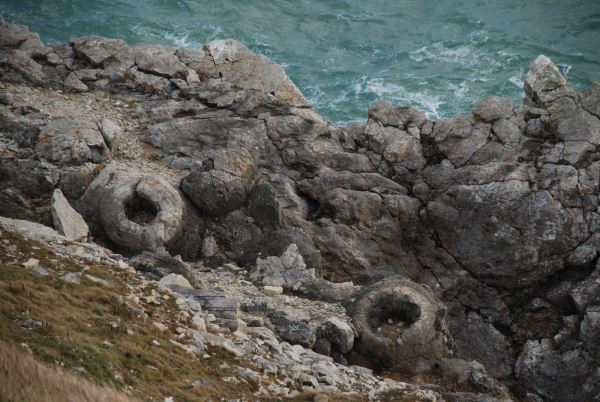Jurassic Coast

Covering 95 miles, from Orcombe Point in east Devon to Old Harry Rocks in Dorset, the Jurassic Coast is an unprecedented place where the history from millions of years is lying beneath your feet. In 2001, the coastline was listed as one of the UNESCO’s natural World Heritage sites due to it being one of the most significant Earth Science locations in the world.
The sheer beauty of the coastline that makes this place so special. At 18 miles long, Chesil Beach, with the Fleet Lagoon behind it, is probably the single largest feature of the coastline. The entire length is made of pebbles that gradually increase in size from pea sized at West Bay to cobbles at Portland. Other famous landmarks include Old Harry Rocks, Durdle Door, Lulworth Cove, and the stacks at Ladram Bay, all shaped by nature and well worth seeing.
History
This is the only place in the world where the geology, exposed in cliffs for all to see, is a near-continuous sequence of rocks revealing 185 million years of the Earth’s history. A walk along the coast is like taking a ‘walk through time’, through the Triassic, Jurassic and Cretaceous periods of geological time.
.jpg)
As storms erode the cliffs a variety of fossils are revealed, with one of the largest finds in recent years being a fearsome pliosaur, a monster beast measuring up to 16 metres in length that would have roamed the seas 150-million years ago. The fossilised skull is now on permanent display at the Dorset Museum and Art Gallery in Dorchester
Fossil hunting is great fun but keep well away from the base of the cliffs as cliff falls can take place at any time of year. The safest and most rewarding way of trying it yourself is by joining an experienced guide, which you can do at Lyme Regis and Charmouth.
Fun Facts
- The Jurassic Coast was the UK’s first UNESCO World Heritage Site.
- The Jurassic Coast is a whopping 95 miles long.
- The name “Jurassic Coast” derives from the fact that it uncovers history from the Jurassic, Triassic and Cretaceous periods.
- Geologists regards the area as one of the most significant educational sites in the world.

Ways to see the Jurassic Coast
The B3157 coast road is a particularly scenic route between Weymouth and Bridport. You can travel on the Jurassic Coaster buses which will take you primarily along the Jurassic Coast in Dorset between Poole and Lyme Regis. The X53 bus departs from Weymouth and travels East to Axminster (above Lyme Regis), where you can stop off at places such as Abbotsbury, Burton Bradstock, Bridport and West Bay. The X51 travels West towards Poole, passing the famous Durdle Door and Lulworth Cove. Take a look at more stops and the relevant timetables here.
People have been visiting this part of the country and enjoying all it can offer for centuries. And if you enjoy walking, the South West Coast Path covers all 95 miles, so you will not miss a thing!
What to see and do on Dorset's Jurassic Coast
 Swan InnAbbotsbury
Swan InnAbbotsbury Vurlands Animal Farm & Egg Cup TearoomsBridport
Vurlands Animal Farm & Egg Cup TearoomsBridport First Buses - Jurassic CoasterWeymouth
First Buses - Jurassic CoasterWeymouth Coastline CruisesWeymouth
Coastline CruisesWeymouth Cove House InnPortland
Cove House InnPortland Jurassic Fun CentreBridport
Jurassic Fun CentreBridport Lulworth Castle & ParkLulworth
Lulworth Castle & ParkLulworth Lulworth Cove InnLulworth
Lulworth Cove InnLulworth Purbeck BreezerPoole
Purbeck BreezerPoole Sea Fishing PoolePoole
Sea Fishing PoolePoole Portland Bill Lighthouse & Visitor CentrePortland
Portland Bill Lighthouse & Visitor CentrePortland Deli on the QuayPoole
Deli on the QuayPoolePlease share or leave a comment
More Places of Interest
Places to Go
Find places to go and things to do in Dorset using the options below.
Dorset Events
Latest Dorset Features
.jpg) Your guide to the best places for local produce, gifts & foodie treats this season
Dorset is blessed with a wonderful selection of farm shops, delicatessens and country stores, perfect for festive food shopping, hamper goodies, stocking fillers and seasonal treats. Whether you’re hunting for award-winning local meats, artisan bakes, unique gifts or simply a great place to stop for a cosy coffee, these farm shops are well worth a visit this Christmas.
Below is our ... Read more...
Your guide to the best places for local produce, gifts & foodie treats this season
Dorset is blessed with a wonderful selection of farm shops, delicatessens and country stores, perfect for festive food shopping, hamper goodies, stocking fillers and seasonal treats. Whether you’re hunting for award-winning local meats, artisan bakes, unique gifts or simply a great place to stop for a cosy coffee, these farm shops are well worth a visit this Christmas.
Below is our ... Read more...
 You'll find the perfect present while Christmas shopping in Dorset, find unique gifts, local art, Dorset food and drink and much more. We've put together a few ideas to help get you started!
1 – Have you got a tank enthusiast in the family? Take a look at the Tank Museum online shop: from baubles to model kits and themed T-shirts, their shop has something for everyone.
2 – Looking for some foodie gifts this ... Read more...
You'll find the perfect present while Christmas shopping in Dorset, find unique gifts, local art, Dorset food and drink and much more. We've put together a few ideas to help get you started!
1 – Have you got a tank enthusiast in the family? Take a look at the Tank Museum online shop: from baubles to model kits and themed T-shirts, their shop has something for everyone.
2 – Looking for some foodie gifts this ... Read more...
 ‘Tis the season to be jolly, and you will be when you discover the fantastic selection of Christmas markets and festive fairs that are set to be held around Dorset in the coming weeks.
If you’re getting organised with your Christmas shopping, these events are a great way to find those perfect gifts. If delicious Dorset food and drink is on your wish list, then you’ll love the tasty selection available from local producers; or maybe you’d like a day out to ... Read more...
‘Tis the season to be jolly, and you will be when you discover the fantastic selection of Christmas markets and festive fairs that are set to be held around Dorset in the coming weeks.
If you’re getting organised with your Christmas shopping, these events are a great way to find those perfect gifts. If delicious Dorset food and drink is on your wish list, then you’ll love the tasty selection available from local producers; or maybe you’d like a day out to ... Read more...

